Parisian Walkways: Rue Véron, A Quieter Part of Montmartre

Back in 1929, Édith Piaf was still known as Édith Giovanna Gassion. Then 14 years old, the future chanteuse spent her days following her father around France with his touring acrobatic act. But La Môme Piaf, the little sparrow, as she’d one day be known, would soon spread her wings. With her friend Simone Berteaut, she began romping about the streets of Belleville in her spare time, singing songs for money. By around 1930, she’d scraped enough together to leave her father’s act and make her first big move. Piaf settled in Montmartre, renting a room at 18 rue Véron, in a humble lodging house originally built for the workers erecting the Sacré-Cœur basilica: the Grand Hôtel de Clermont.
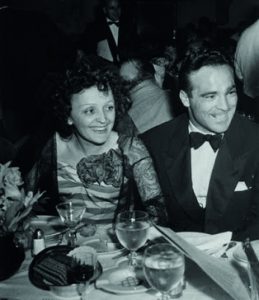
Édith Piaf with the boxer Marcel Cerdan in 1948 or 1949
Living on rue Véron, a back street parallel to rue des Abbesses, between rue Lepic and rue Germain-Pilon, Piaf could busk on the nearby sidewalks of Pigalle, and cut her performance teeth at the legendary Montmartre cabaret Le Lapin Agile. By 1935, she’d been discovered by nightclub owner Louis Leplée, had embraced her stage name, and launched a globetrotting singing career. Imagine the extraordinary twist of fate when, in 1948, Piaf, by then an international star, first went to meet the love of her life, world heavyweight champion Marcel Cerdan, for a drink and found herself stepping into the bar of the Grand Hôtel de Clermont. Cerdan’s boxing club, it turned out, was situated exactly next door to where Piaf had lived as a penniless, aspiring artist nearly two decades before.
Remarkably, the Grand Hôtel de Clermont still stands. And though the profile of the hotel guests has evolved from struggling artists to budget-hunting tourists, the bar, with its mosaic floor and 1920s zinc counter, has hardly changed since the era when Piaf and Cerdan came here to sip cocktails and chat in the corner. Renowned among lovers of atmospheric watering holes, it’s now simply known as Chez Ammad, after its proprietor of nearly 40 years.
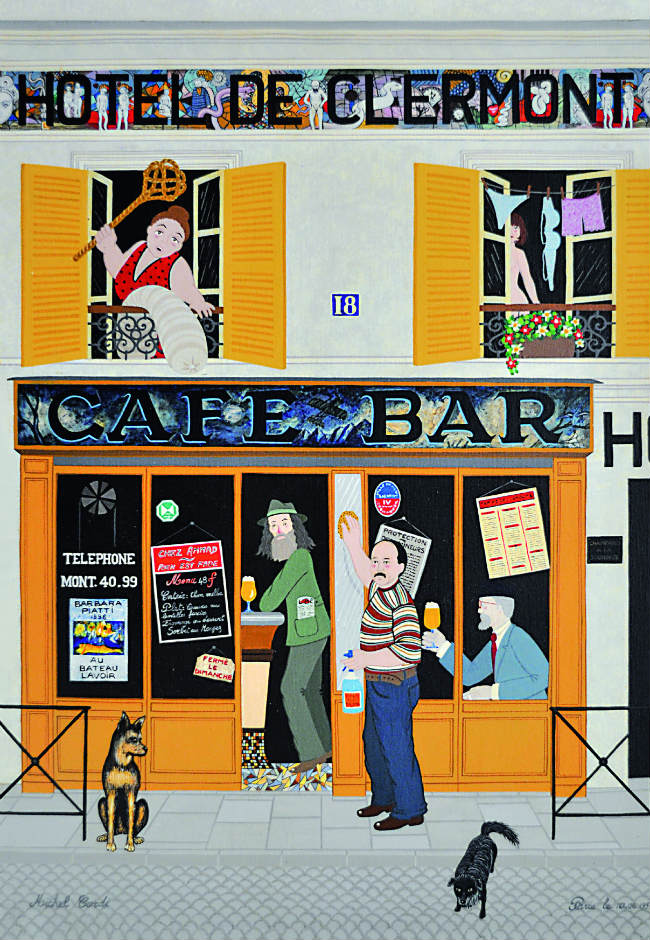
The Grand Hôtel de Clermont, aka ‘Chez Ammad’, depicted by Michel Cordi. Courtesy of Grand Hôtel de Clermont
Guardian of neighbourhood lore, Ammad’s walls are covered with historic photos and strange and vibrant murals painted by former hotel residents. In some, Ammad himself is the subject, as in a colourful 1997 tableau painted by French naïf artist Michel Cordi. “This bar has something special,” says Ammad, “So many artists and amazing characters have passed through here, it’s really the whole history of the quartier. And that’s why people come – for the ambience of this neighbourhood.”
Today, rue Véron’s bygone-era atmosphere is proving especially appealing to young entrepreneurs fleeing the charm-killing invasion of chain stores on more frequented Paris walkways. After a period of slow decline, rue Véron has been enjoying an injection of new life in recent years, thanks to the arrival of several new artisans, restaurateurs and gallerists.
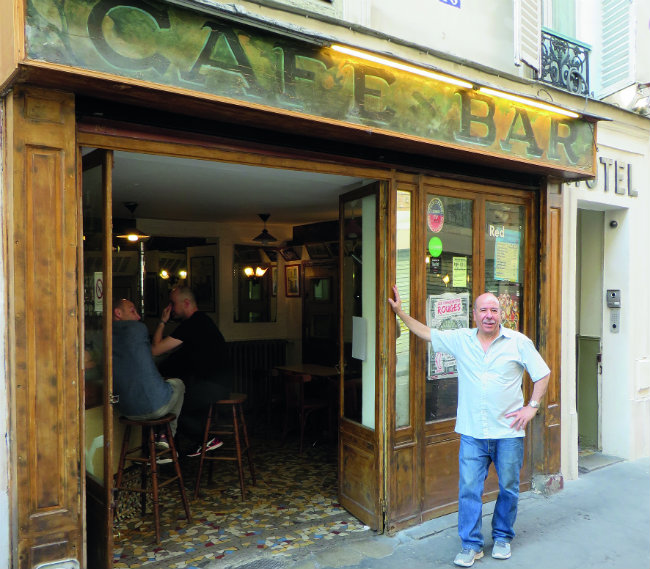
Chez Ammad. Photo: Jeffrey T Iverson
“I really believe in the power of Montmartre’s history on the collective imagination,” says Joël Knafo, who opened his eponymous contemporary and urban art gallery in 2016 at 21 and 24 rue Véron. “That’s what I love about this street. It carries the memory of Montmartre when it was the beating heart of art. Most artists left long ago, but there is this soul that remains, and that’s what excites me about working here.”
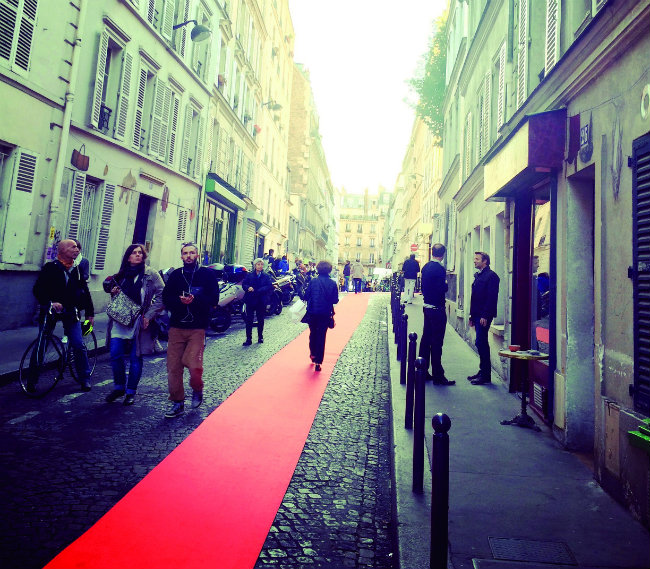
Joel Knafo Gallery opening in 2016. Photo: Les Petits Points Parisiens
Rue Véron may be just a minor thoroughfare in the shadow of Abbesses, but it has been home to many prodigious talents beyond Édith Piaf. When artists flooded into Montmartre in the 1870s, Ilya Repin, the most renowned Russian painter of the 19th century, set up his atelier on rue Véron. A few years earlier, French novelist Henri Murger, author of Scènes de la Vie de Bohème – the classic story of impoverished young artists in Paris that inspired Puccini’s opera La Bohème – had spent the last years of his short life at 11 rue Véron. Even the protagonist of Émile Zola’s scandalous 1880 novel Nana was described as residing in a cramped fourth-floor apartment on rue Véron. Perhaps most inspiring for young Piaf, though, would have been the knowledge that two doors from her hotel, at 15 rue Véron, had lived Montmartre’s most celebrated chansonnier – Jean Baptiste Clément (1836-1903), composer of perhaps the most performed song in the French language, Le Temps des Cerises.
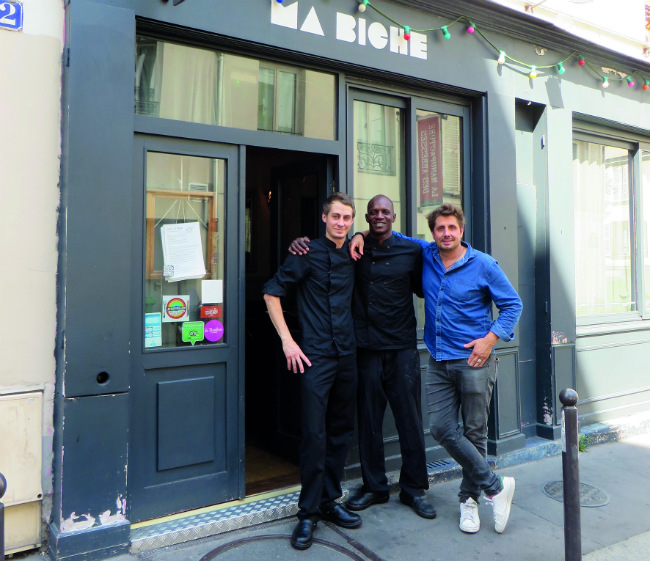
Restaurant Ma Biche. Photo: Jeffrey T Iverson
As a new generation re-energises the street today, it’s clear rue Véron still inspires creative spirits. “The present is always nourished by the past,” muses Serge Bulard, co-founder of the restaurant Ma Biche (12 rue Véron). Originally an ethnologist and documentary filmmaker of rural life, Serge has created an eatery at once nostalgic and avant-garde. His décor mixes kitsch wallpaper and hand-me-down furniture from grandma with contemporary lamps and wall projections of silent Buster Keaton and Charlie Chaplin films. Humble dishes are enlivened with unexpected pairings – razor clams with passion-fruit butter, duck leg with orange confit, crème brûlée with truffled turnip. “Hidden away on this street, the restaurant is like a little world to discover,” he says. “With our cuisine, our artwork and our films, we try to transport people to another place.”
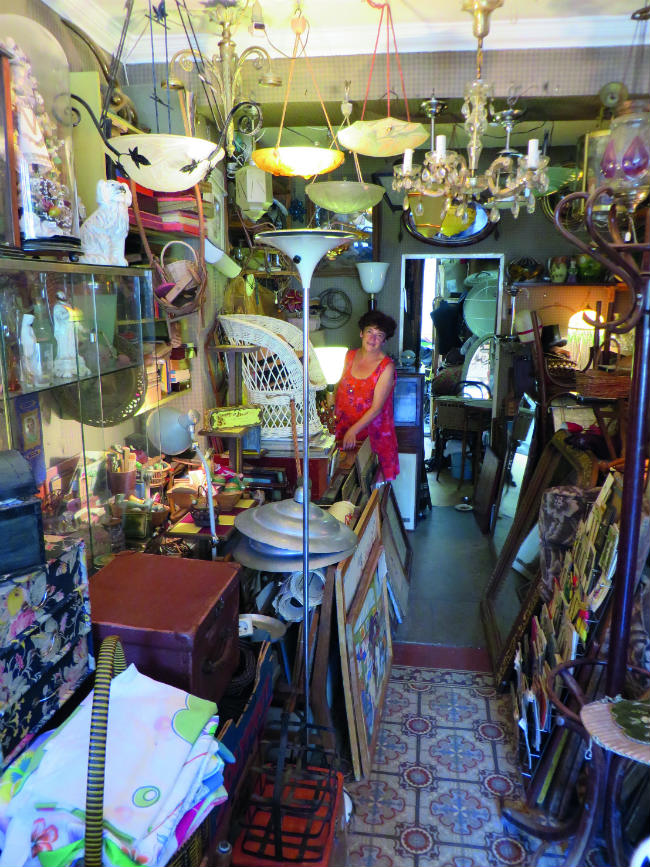
Catherine Jacquet at her Atelier Brocante. Photo: Jeffrey T Iverson
At 34 rue Véron, Catherine Jacquet brings a similar approach to antiques. Her late father was an étalagiste, or window display designer, and she carries on that tradition, creating elaborate, amusing scenographies for every season. “I love to create window displays that tell a story,” she says, calling her unique shop, founded in 1983 – with its mix of dolls and childhood-themed memorabilia, vintage lamps, and period fabrics going back to the late 1800s – an atelier-brocante, or antiques-workshop. “A workshop not in the sense of restoration, but in the sense of creation.”
Much like the French surrealist artists who sought inspiration in antiques and curiosity shops, Jacquet’s clientele includes fashion designers, graphic artists and collectors of renown (including André Breton’s daughter, Aube). “What I love is when a bit of old lace I sell can inspire a whole new dress. It’s what I hope for all my collection, that it will have another life, by feeding others’ imaginations.”
Besides artists, a new generation of 30-to-40-somethings, recently arrived in the neighbourhood, are increasingly knocking on Jacquet’s door for furniture and decorative ideas. “They’re tired of IKEA,” she says, “and want to personalise their apartments with something unique.” Unfortunately, one-of-a-kind shops like Jacquet’s have become rare in Montmartre today. “In 15 years, this neighbourhood has completely changed. Rue des Abbesses is slowly losing its identity, as chain stores, banks or beauty salons replace every butcher or independent food shop that closes,” she says. “Yet this little street has really preserved its Montmartrois character. There’s something special about it and the people here.”
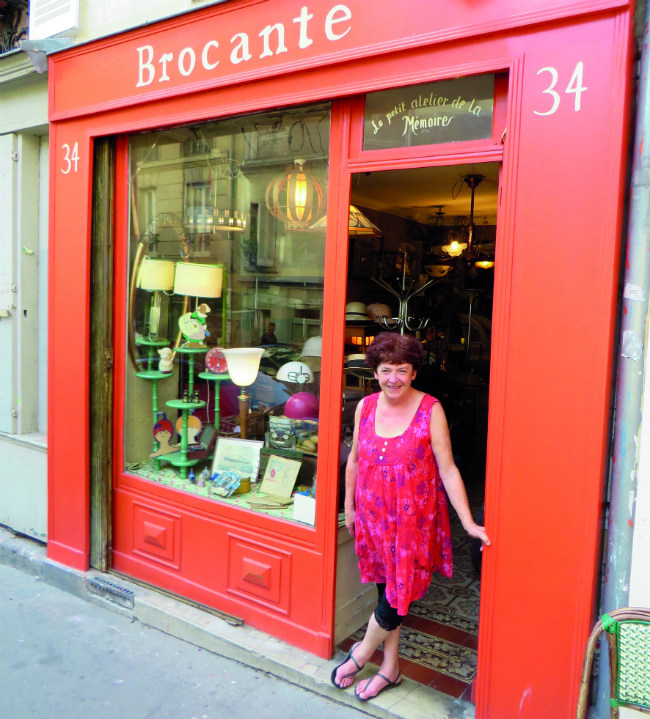
Atelier Brocante. Photo: Jeffrey T Iverson
Rue Véron as a bastion of authenticity and character? It’s a poetic notion for a street whose name recalls a time when Montmartre was a rebellious independent commune, separate from Paris (Jean-Louis Véron was mayor of Montmartre from 1831- 1842). For Anne Cerruti, who four years ago opened her knitting and sewing shop, Les Petits Points Parisiens, at 24 rue Véron, it is indeed such a bastion. “Chez Ammad is full every night of people from all over, precisely because it is a real bar de quartier, not a tourist trap,” she says. “And it’s the same with my shop; we draw people from all over the neighbourhood, France, and abroad as well, because I work with real artisan products – cashmere, Pyrénées mohair and a kaleidoscope of wool hand-dyed in Montmartre – not industrial wools or acrylic.”
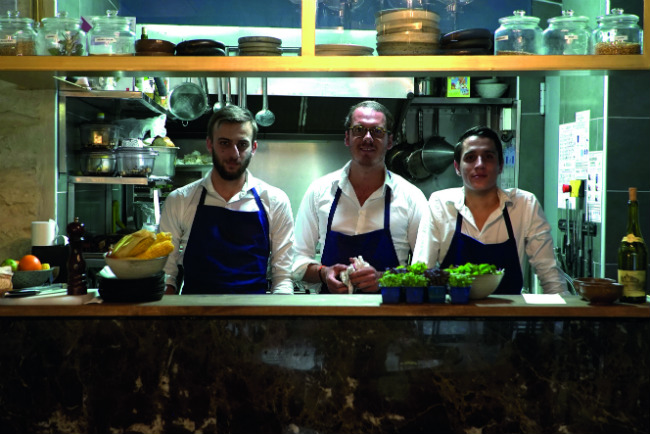
Kitchen staff at the Restaurant Vava. Photo: Arsedi
The street’s gastronomic establishments share that philosophy. “Too often in Montmartre it’s defrosted croques-monsieurs and salads for €18,” says Enzo Nicaise, co-founder of the Mediterranean hotspot Vava, at 42 rue Véron. “There is a demand here for accessibly-priced cuisine based on fresh, seasonal produce that will awaken your senses.” Vava is responding to this, as is the new néo-bistrot at No. 29, Padam Padam (named after the iconic song by Piaf), as well as the chic Les Tantes Jeanne, also at No. 42, a carnivore’s paradise offering Kobe beef let, sweetbread and porcini cassolette, and turbot in salt crust. “Just because there are tourists isn’t an excuse to create a tourist trap,” agrees Eric Carrillo, co-founder of the rue Véron gourmet speciality shop Appellations d’Origine. “We want visitors to France to leave here with real artisanal French products, not industrial imitations. We’d rather close the shop than sell cognac in Eiffel Tower bottles!”
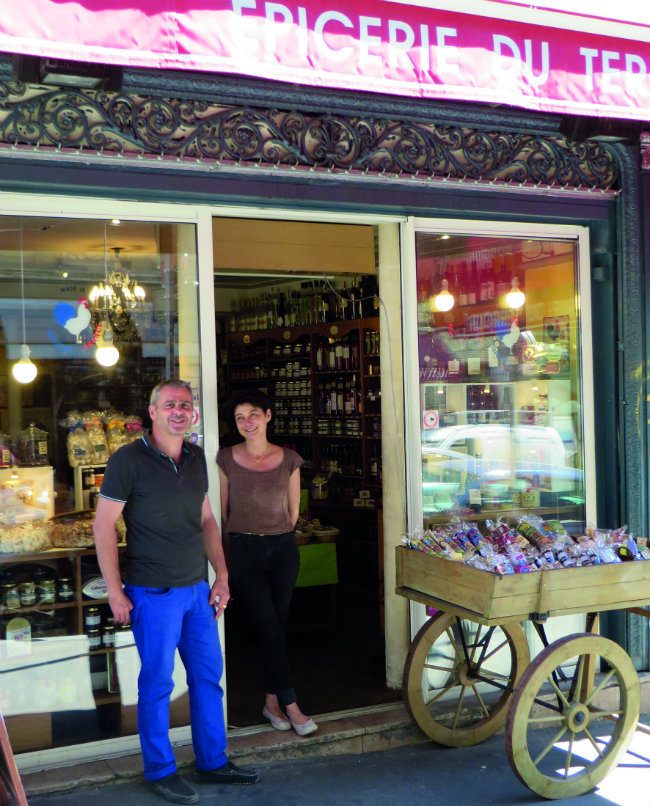
The gourmet speciality shop, Appellations d’Origine. Photo: Jeffrey T Iverson
For all rue Véron’s delights, only recently has it begun to gain media attention, thanks in part to a handful of dynamic art galleries. “Really there is no reason to go down rue Véron; it’s parallel to rue Abbesses, and thus is rarely taken,” says Joël Knafo. “But to me, it seemed this street with such history and such potential could be a real destination again.”
Sharing that conviction is Tristan Cormier, owner of Galerie Hus (4 rue Aristide Bruant), who created the gallery Jeudi Soir (27 rue Véron) last year to “re-inject a little life into the neighbourhood”. His idea was to offer Thursday-night wine and art openings, while also “encouraging other locations to open themselves up to the street to create moments of conviviality”.
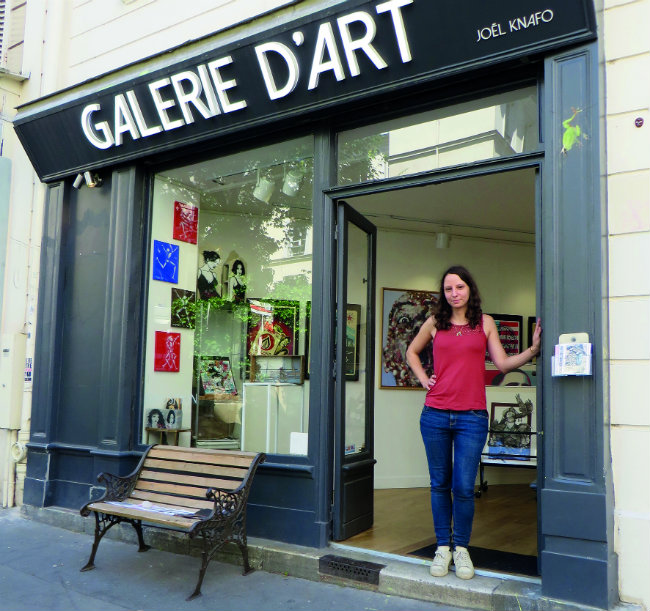
Joël Knafo’s gallery. Photo: Jeffrey T Iverson
A street-wide, open-door Thursday night tradition resulted, dubbed Les Jeudis de la rue Véron, which took on a grand scale last October when gallerist Joël Knafo inaugurated his two rue Véron gallery spaces. To help celebrate the occasion, urban artists Levalet and Philippe Hérard joined forces to create a monumental mural spanning the entire street, depicting a huge laundry line, stretched from building to building and hung with all sorts of unexpected objects – like a Santa Claus outfit, a tuna fish, a scuba diver, an elephant…
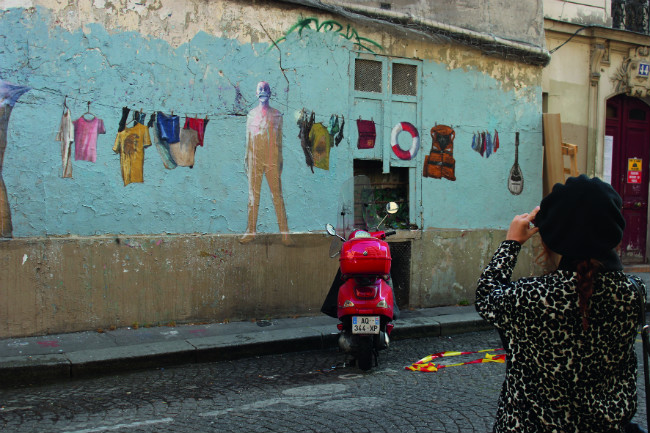
The now famous washing line mural that adorns the street. Photo: Joel Knafo
The mural has become a vibrant metaphor for what rue Véron’s business owners value and hope to preserve about their street. “There’s this neighbourhood life that thrives in a few streets just off the beaten track in Montmartre – a real vie de quartier,” says Knafo. “With exhibitions like this, I want to continue to créer du lien – to create a link between the inhabitants of Montmartre.”
It’s a sentiment that certainly hits home with at least one resident. “This is my home, it’s my village, and I don’t want it to lose its identity,” says Ammad from behind his zinc bar. “In the end, it’s why people come: there’s a soul to this place.” Ammad pauses, then adds with a wink: “And of course it helps that my drinks are cheaper than anyone else’s.”
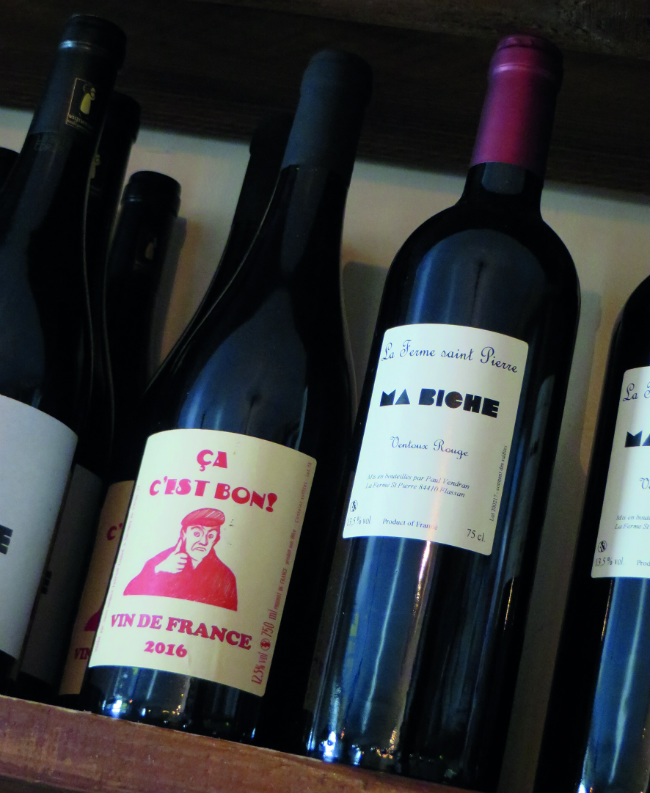
Wines on show at Ma Biche, a restaurant launched in 2014 in defiance of the touristy eateries that have taken over much of Montmartre. Photo: Jeffrey T Iverson
BOUTIQUES, RESTAURANTS AND GALLERIES
Appellations d’Origine: 26 rue Lepic, Tel. +33 (0)1 42 62 94 66
Founders Isabelle and Eric call their gourmet food shop “a Tour de France of gastronomy,” and it is. From genuine Nougat de Montélimar, to Édouard Artzner’s inimitable Alsace-made foie gras, Jean-Philippe Mandard’s famous Alps honey and authentic Provençal bouillabaisse fish stew from a tiny producer in Sète, Appellations d’Origine celebrates the flavours of France’s every region.
Atelier-Brocante: 34 rue Véron, Tel. +33 (0)1 42 58 95 13
Some antique shops are simply collections of old junk, but Catherine Jacquet’s atelier-brocante, or ‘antiques-workshop’, is an oasis of imagination. Her inventive, thematic window displays, which evolve with every season, set the playful tone for her shop; a lovingly assembled selection of dolls, toys, lamps, paintings, postcards, furniture, fabrics and couture items from 1880 to 1950.
Joël Knafo Art, 21 & 24 rue Véron, Tel. +33 (0)7 81 61 21 57
Joël Knafo moved his gallery from the 13th district to rue Véron in 2016, drawn by “the power of Montmartre’s history.” It’s no longer the locus of the art world, yet the artistic avant- garde has returned to Montmartre thanks to Knafo, showing the works of contemporary and street artists like Shepard Fairey, Philippe Hérard, Gottfried Salzmann and Speedy Graphito.
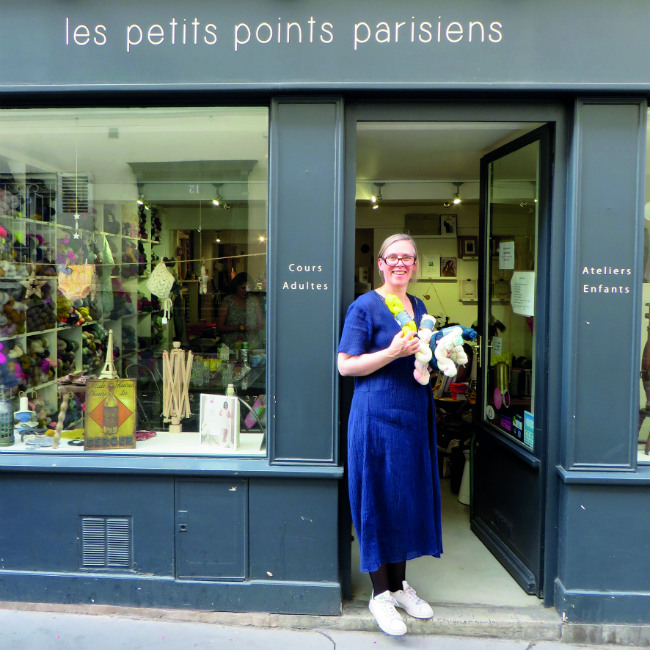
Les Petits Points Parisiens. Photo: Jeffrey T Iverson
Les Petits Points Parisiens, 24 rue Véron, Tel. +33 (0)1 72 34 77 37
For knitters, crocheters and DIY enthusiasts, Anne Seruti’s colourful yarn shop is one of a
kind. Offering premium yarns made of hand-dyed cashmere, wool from the Alps or mohair from the Pyrénées and other rare materials, this lively shop also hosts sewing classes and weekly Apéro tricots, when knitters share ideas over a drink.
Chez Ammad, 18 rue Véron, Tel. +33 (0)1 46 06 40 99
“The best neighbourhood bar in Paris,” says Time Out magazine. For nearly 40 years, the bar of the humble yet historic Grand Hôtel de Clermont has been manned by its kindly owner, Ammad. From behind the zinc bar where Marcel Cerdan and Édith Piaf once sipped cocktails, surrounded by murals painted by former hotel residents, Ammad offers inexpensive drinks and a priceless ambience.
Ma Biche, 12 rue Véron, Tel. +33 (0)1 42 58 22 20
Ma Biche is about hearty, creative cuisine and ingredients sourced directly from the farm. Co-founder Serge, a filmmaker who documented peasant life, knows many artisanal cheese, meat and vegetable producers – and their tales to boot. A décor of antiques and grandma’s furniture, old silent movies projected on the wall… Here, dinner is an evening of storytelling.
From France Today magazine
Share to: Facebook Twitter LinkedIn Email
Leave a reply
Your email address will not be published. Required fields are marked *




REPLY